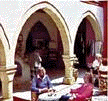![]()
 NICOSIA
NICOSIA 
![]()
Nicosia
is the capital of Cyprus, a status it has enjoyed for 1000 years since the 10th century, though its beginnings date back 5000 years to the Bronze Age. It lies roughly in the centre of the island in the Mesaoria Plain, flanked by the beautiful northern range of Kyrenia mountains with its distinctive 'Pentadaktylos" - the five finger mountain. There are various suggestions as to the origin of the name Nicosia - or 'Lefkosia' In Greek - but the most likely one is linked to the popular tree, the tall 'Lefki ' which once adorned the city.Seat of Government, Diplomatic headquarters and cultural centre of Cyprus, the capital presents two distinct faces: the old, original part of the city, surrounded by sturdy Venetian walls over 400 years old, and a busy modern metropolis which has a population of 171.000 together with the suburbs. . .
Within the large area encircled by the strong bastion walls that served to protect the town for centuries are many places of great historic interest.
The central Eleftheria Square links old Nicosia with the elegant modern city that has grown up outside the walls, where hotels, offices restaurants and gardens blend happily with the fine old houses and colonial buildings of this cosmopolitan city.
 PLACES OF INTEREST
PLACES OF INTEREST 
![]()
1.CYPRUS MUSEUM
Muscum Street Tel: (02)30-2189
Priceless and fascinating collection of Cypriot antiquities and art treasures from the Neolithic Age to the early Byzantine Period.
2. BYANTINE MUSEUM AND ART GALLERIES
Arch. Makarios III Foundation, Cultural Centre, within the Archbishopric, Arch. Kyprianos Square Tel: (02) 456781.
Largest collection of icons on the island, covering the period from 9th to 18th century. The Art Galleries contain oil paintings, maps, lithographs etc.
3. FOLK ART MUSEUM

Within the Old Archbishopric, Arch. Kyprianos Square Tel: (02) 463205.
Wide collection of Cypriot folk art of the 19th and early 20th century, including wood-carved objects, tapestry, embroidery, pottery, national costumes and hand-woven materials.
4. NATIONAL STRUGGLE MUSEUM
Near the Archbishopric, Arch. Kyprianos Square Tel: (02)30-2465
Documents, photos and other memorabilia of the 1955-1959 National Liberation Struggle.
5. AYIOS IOANNIS CATHEDRAL
Within the Archbishopric, Arch. Kyprianos Square.
Built by Archbishop Nikiforos in 1662, the recently restored 18th century wall paintings depict biblical scenes and the discovery of the tomb of Saint Barnabas at Salamis. Dedicated to Ayios loannis (Saint John).
6. ARCHBISHOPRIC

Centre of the Cyprus Orthodox Church, the new Archbishopric built in a neo-byzantine style in 1960, contains the private suite of the late Archbishop Makarios. Open to the public only on special occasions.
7. HOUSE OF HADJIGEORGAKIS KORNESSIOS
Patriarch Gregoriou Street near the Archbishopric.
Originally a Venetian Building. It is probably the most important 18th century building in Nicosia. It was once the house of the Dragoman Hadjigeorgakis Kornessios. The house is being restored and will house the Cyprus Ethnographic Museum. Hadjigeorgakis Kornessios house has won the Europa Nostra award in 1988.
8. FAMAGUSTA GATE

Nikiforos Phokas Avenue Tel: (02) 430877
The Venetian walls which completely encircle the old city have a circumference of 4.5 km and possess eleven heart-shaped bastions. There were only three entries to the city through gates, in the north, south and east. One of these gates, the Porta Giuliana, called the Famagusta Gate has been restored and is now the Nicosia Municipal Cultural Centre. The large imposing gate itself leads into a long passage with a central cupola, which cuts through the walls and comes out in the moat. On both sides are high, stonewalled guard-rooms. The restored passage and rooms arc used for exhibitions, conferences, Iectures and various performances. The oId quarter of the town, close to the Famagusta Gate, is also beinR restored.
9. CHRYSALINIOTISSA CHURCH
Within walking distance from the Archbishopric. Considered the oldest Byzantine church in Nicosia it is dedicated to 'Our Lady of the Ciolden Flax' and is believed to have been built in 1450 by Queen Helena Palaeologos.
10. LAIKI YITONIA

Rcstored pedestrian area within the walled city, east of' Eleftheria Square. Charming winding alleys with traditional houses and shops, restaurants, galleries, all lovingly restored as typical examples of Cypriot urban architecture of a bygone, more graceful age.